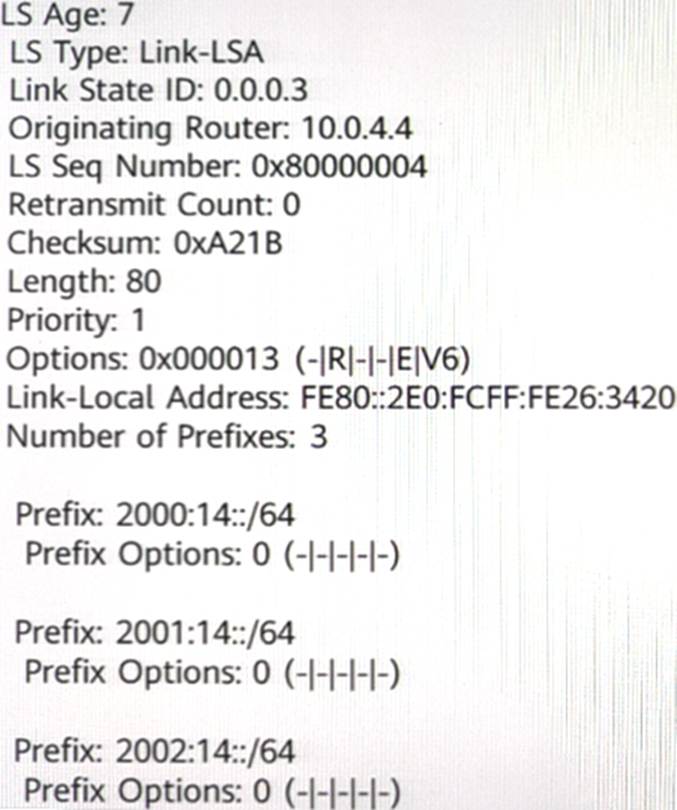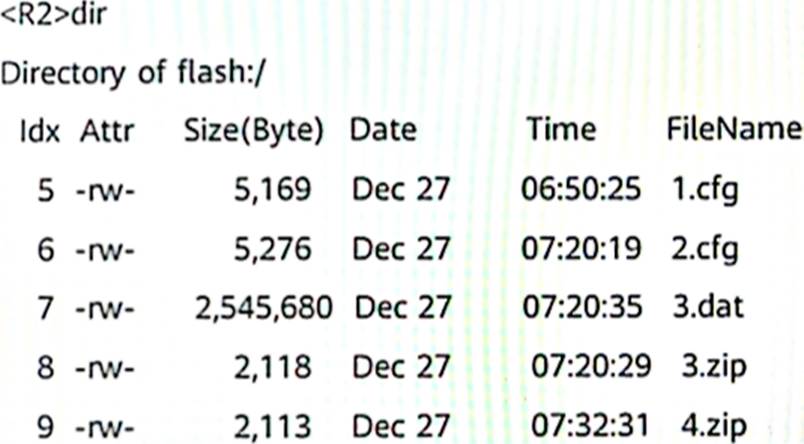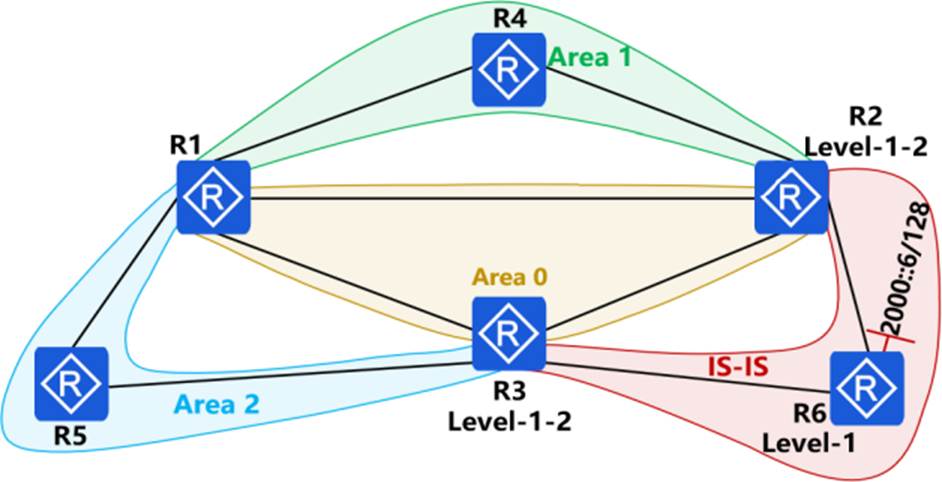Practice Free H12-831_V1.0-ENU Exam Online Questions
As its network scale expands, an enterprise plans to move scattered servers to the same equipment room for unified management. During hardware migration, network engineers do not need to perform device commissioning and therefore do not need to work out a migration solution.
- A . TRUE
- B . FALSE
The Link-LSA generated by an OSPFv3 router is shown in the figure.

Which of the following is the number of global unicast addresses configured on the interface?
- A . 4
- B . 3
- C . 1
- D . 2
Port security is achieved by converting the dynamic MAC address learned by the interface into a secure MAC address, including secure dynamic MAC, secure static MAC and sticky MAC.
Which of the following descriptions about secure MAC addresses are correct? (Multiple choice)
- A . If you manually save the configuration and restart the device, the secure static IAC address information will be lost
- B . The difference between secure dynamic MAC and sticky MAC is that the MAC table entry of the former will be lost after the device is restarted.
- C . By default, these three types of MAC address information will not be aged.
- D . Port Secure Dynamic MAC and Sticky MAC both convert dynamically learned MAC addresses into secure addresses
The file information shown in the figure exists on the R2 device. When the network engineer uses the "dir | exclude 1" command to view the file information, which of the following files will be seen?

- A . 4.zip
- B . 3.dat
- C . 1.cfg
- D . 2.cfg
On a PIM-SM multicast network, a network engineer finds that multicast clients cannot receive multicast data.
Which of the following is not a possible cause of this problem?
- A . The unicast routes from multicast devices to the RP are unavailable.
- B . The downstream interfaces of multicast devices do not receive any (*, G) Join messages.
- C . Downstream interfaces of multicast devices are disabled from forwarding State-Refresh messages.
- D . The RP addresses of multicast devices are different.
On the OSPFv3 network shown in the figure, area 1 is a common are R2 generates an Inter-Area-Prefix-LSA to describe the routes of a network segment in the area. Such an LSA exists in both area 0 and area 1.

- A . TRUE
- B . FALSE
A
Explanation:
Comprehensive and Detailed In-Depth
To determine whether the statement is true or false, we need to analyze the OSPFv3 topology, the role of area types, and the behavior of Inter-Area-Prefix-LSAs.
Let’s break it down step by step:
Understanding the OSPFv3 Topology and Area Types:
The figure shows three routers (R1, R2, and R3) connected in an OSPFv3 network. R1 and R2 are in
Area 0 (the backbone area), while R2 and R3 are in Area 1 (a common area, also known as a standard or regular area).
R2 is an Area Border Router (ABR) because it connects Area 0 and Area 1. ABRs are responsible for summarizing and advertising routes between areas.
What is a Common Area in OSPFv3?:
A "common area" in OSPFv3 refers to a standard or regular OSPF area, as opposed to special areas like Stub, Totally Stubby, Not-So-Stubby Area (NSSA), or Totally NSSA. Common areas allow all types of LSAs, including inter-area, intra-area, and external LSAs, to be flooded within the area, except for restrictions in special area types.
Since Area 1 is described as a "common area," it behaves like a standard OSPF area, allowing the full exchange of LSAs, including Inter-Area-Prefix-LSAs.
Role of Inter-Area-Prefix-LSA (Type 3 LSA in OSPFv3): Inter-Area-Prefix-LSAs (Type 3 LSAs in OSPFv3) are used by ABRs to advertise prefixes from one area to another. These LSAs are critical for inter-area routing, allowing routers in one area to learn about networks in other areas.
In this case, R2, as an ABR, generates Inter-Area-Prefix-LSAs to describe routes (network segments) in Area 1 and advertises them into Area 0. Conversely, R2 also receives Inter-Area-Prefix-LSAs from Area 0 (via R1) and advertises them into Area 1.
Does the Inter-Area-Prefix-LSA Exist in Both Area 0 and Area 1?:
Yes, Inter-Area-Prefix-LSAs exist in both areas because R2, as an ABR, floods these LSAs into both
Area 0 and Area 1. Specifically:
R2 generates Inter-Area-Prefix-LSAs for network segments in Area 1 and advertises them into Area 0, where R1 (in Area 0) can receive and process them.
Similarly, R2 receives Inter-Area-Prefix-LSAs for network segments in Area 0 (from R1) and advertises them into Area 1, where R3 (in Area 1) can receive and process them.
Since Area 1 is a common area (not a stub or NSSA), it allows Inter-Area-Prefix-LSAs to be flooded within the area, ensuring that routers like R3 can learn about routes in Area 0, and routers like R1 can learn about routes in Area 1.
Verifying the Statement:
The statement claims that R2 generates an Inter-Area-Prefix-LSA to describe the routes of a network segment in Area 1, and such an LSA exists in both Area 0 and Area 1. This is accurate because:
R2, as an ABR, generates Inter-Area-Prefix-LSAs for Area 1’s network segments and floods them into Area 0.
R2 also receives and floods Inter-Area-Prefix-LSAs from Area 0 into Area 1.
Therefore, Inter-Area-Prefix-LSAs describing routes in Area 1 exist in both Area 0 and Area 1, making the statement true.
Conclusion:
The statement is true because Inter-Area-Prefix-LSAs generated by R2 for Area 1’s network segments are flooded into both Area 0 and Area 1, and Area 1, being a common area, allows these LSAs to exist within it.
Reference to HCIP-Datacom-Advanced Routing & Switching Technology Documents:
HCIP-Datacom-Advanced Routing & Switching Technology V1.0, Section on OSPFv3: OSPF Area Types, Inter-Area Routing, and LSA Types (specifically Inter-Area-Prefix-LSA, Type 3 LSA).
HCIP-Datacom-Advanced Routing & Switching Technology V1.0, Chapter on OSPF Routing Protocols:
ABR Behavior, Common Areas, and LSA Flooding Mechanisms.
The MPLS architecture is divided into a control plane and a forwarding plane, which contains multiple protocols and tables.
Which of the following tables is responsible for forwarding packets with MPLS labels?
- A . Forwarding Information Table FIB
- B . Label Information Table LIB
- C . Road and electricity information table RIB
- D . Label Forwarding Information Table LFIB
When the hardware of a network device fails, you can usually use the replacement method, such as replacing the optical module, replacing the board, replacing the power module, etc. When performing the above operations, you need to wear an anti-static wrist strap.
- A . True
- B . False
When the hardware of a network device fails, you can usually use the replacement method, such as replacing the optical module, replacing the board, replacing the power module, etc. When performing the above operations, you need to wear an anti-static wrist strap.
- A . True
- B . False
In the network shown in the figure, IS-IS IPv6 runs between R2, R6, and R3, and the IPv6 address of R6 Looback0 interface is 2000::6/128. Other links run OSPFv3, area 1 is a Stub area, and area 2 is an NSSA area.

IS-IS routes are imported into SPFv3 on R2 and R3.
Which of the following descriptions are correct? (Multiple choice)
- A . R4 routing table has a routing entry for 2000::6/128
- B . R1 routing table has a routing entry for 2000::6/128
- C . R5 routing table has a routing entry for 2000::6/128
- D . R6 routing table has a routing entry of ::/0
